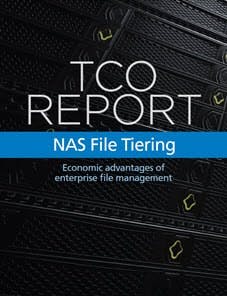Storage growth isn’t slowing down, and this is pushing demand for file storage capacity. As a result, enterprise file management is top of mind for many data centers and businesses. And new storage technologies are bringing storage tiering to the forefront of the market.
Download the full report.
A recent report from Cloudian compares the total cost of ownership of traditional NAS to the TCO of traditional NAS augmented by file tiering with Cloudian object storage.
Cloudian also shares in detail how object storage can provide a cost-effective platform for long-term storage.
Bottom line: There has been an explosion in data. And it’s not slowing down. The report cites predictions from IDC that show data will grow to a projected 44 ZB in 2020. And new types of content have emerged in recent years, as well. Unstructured data is prevalent, which can be harder to manage and store. The report explores other examples, as well, including media archives, engineering files, bioinformatics, web content storage and more.
At an estimated $2 per GB for 3 years of primary storage, this can add up. But the cost of the storage itself is only the beginning.
Backup and replication with NAS can be expensive. And over the life of a file, according to the report, enterprises can use 10 to 20 times more storage than the original file size. What’s the answer? Cloudian contends data tiering is a viable solution for NAS offload.
Two factors are bringing this type of solution to the forefront of the market. First, the arrival of object storage systems. These types of systems are entering the data center world, as a variety of vendors are offering on-premise object storage systems or “private cloud” storage. Cloudian outlines the benefits of object storage in its report, including efficiency, security, scalability, reduced cost and more.
Secondly, Cloudian cites the emergence of file management software that automates the tiering process to object storage as also driving the growing popularity of storage tiering.
“These solutions, such as Komprise data management software, identify Tier 1 data based on user-defined attributes such as file age, frequency of access, owner and file type,” the report states.
New solutions now enable cost savings with zero impact on user data access.
The full report from Cloudian covers the following topics:
- Storage Growth Isn’t Slowing Down
- The Hidden Overhead: Backups and Snapshots
- Object Storage for Cost-effective, Highly Durable Data Tiering
- Transparent Access for Migrated Data
- TCO Example: Traditional NAS vs. Cloudian — 54 Percent Savings
- Benefits of Object Storage for Tiering
For a more in-depth look at how enterprise file management and storage tiering can help your business, download the full white paper, “TCO Report: NAS File Tiering – Economic Advantages of Enterprise File Management,” courtesy of Cloudian.



